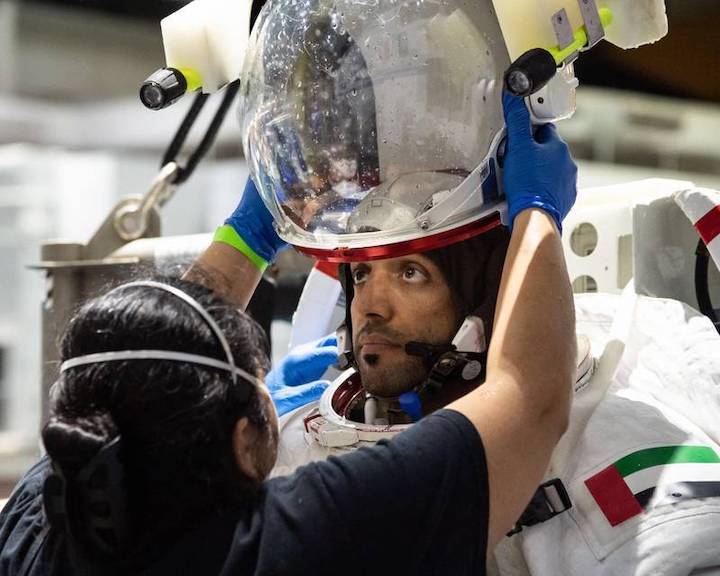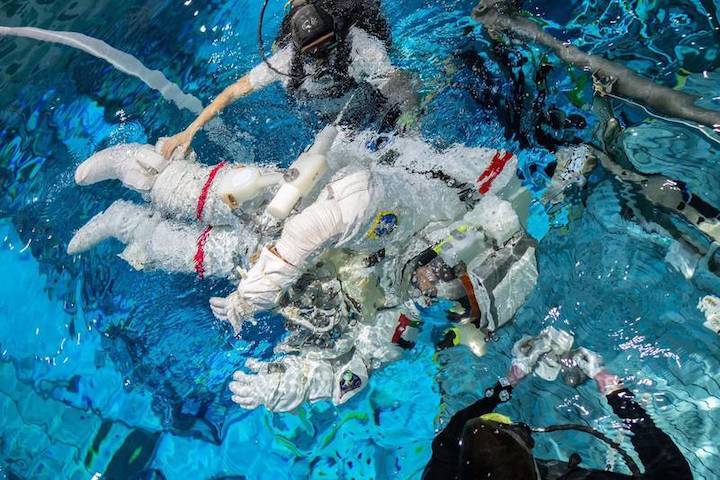11.04.2022
Hazza Al Mansouri and Sultan Al Neyadi prepare for space travel on training programme in the US

Hazza Al Mansouri, first Emirati man in space, wears a 130 kilogram-heavy extravehicular activities suit for spacewalk training. All photos courtesy of Mohammed bin Rashid Space Centre

Sultan Al Neyadi puts his helmet on for spacewalk training under water. Mr Al Neyadi was one of two people selected from 4,022 candidates to become the first Emirati astronauts. Mbrsc

Mr Al Neyadi goes underwater with his EVA suit on for spacewalk training
The UAE’s first two astronauts are being primed for future space missions as they continue training at Nasa's Johnson Space Centre.
Hazza Al Mansouri, the first Emirati to fly to space, and reserve astronaut Sultan Al Neyadi have so far learnt how to perform spacewalks, run the systems on the International Space Station and how to operate its robotic arm since joining up with the agency in October, 2020.
Their training at Nasa facilities was made possible because of a Reimbursable Space Act agreement signed between the US space agency and the Mohammed bin Rashid Space Centre that year.
Training typically lasts for two years, but under the agreement, they will also be readied for long-duration missions, which means their time in Houston could be extended.
“When astronauts are assigned to long-duration expedition missions aboard station, they then receive additional training specifically for their missions and spacecraft,” Nasa said when the agreement was signed in 2020.
“The training via this agreement will prepare the UAE astronauts for future long-duration station missions, but such missions are beyond the scope of this agreement.”
Opportunities open up for space travel
The UAE has not announced any firm plans to send its next astronaut to space, but the space centre is in active discussions with partners to secure a seat on a rocket.
Maj Al Mansouri, a former jet fighter pilot, flew to the ISS on a Russian Soyuzrocket in 2019 for an eight-day stay. The Russian craft was the only one capable of launching human beings into space at the time.
Now, astronauts are also launching from Elon Musk’s SpaceX Falcon 9 rockets from Florida’s Kennedy Space Centre.
This means the UAE now has several options, including a government partnership with Nasa to fly an Emirati astronaut on a SpaceX rocket.
The UAE could also buy launch services from SpaceX as a private customer, or it could collaborate with Russia again.
Astronauts boost expertise on Canada trip
Recently, Maj Al Mansouri and Dr Al Neyadi completed a week-long training stint in Canada, where they learnt how to operate CanadArm2, the robotic arm on the space station.
“One step closer to the next mission,” Maj Al Mansouri tweeted last week.
“We completed recently our training on the robotic arm (CanadArm2), which performs station maintenance, moves supplies, equipment, and even astronauts and grappling visiting vehicles and berthing them to the ISS.”
Dr Al Neyadi tweeted: "A big thank you to the amazing robotics training team at the Canadian Space Agency. During an eight-day training course, I extensively worked on using the robotic manipulator ‘Canada Arm’ to perform various EVA (extravehicular activity) tasks, capture cargo vehicles and handle payloads.”
The two astronauts also completed spacewalk training, which involved spending hours submerged in the world’s largest indoor swimming pool.
Called the Neutral Buoyancy Laboratory, it is 12 metres deep and holds 2.4 million litres of water.
A mock-up of the ISS is built beneath the pool, where astronauts spend more than six hours each time while wearing 115-kilogram extravehicular activity suits.
New recruits get to work
The country’s two new trainee astronauts, Mohammed Al Mulla, a former Dubai Police helicopter pilot and Nora Al Matrooshi, a mechanical engineer, started their training at Nasa in January.
So far, they have completed survival training at the US Army Aviation Centre of Excellence in Fort Rucker, Alabama.
They learnt how to build fires, make shelters and gather food and water, alongside their Nasa colleagues.
They are currently receiving flight training on the T-6 aircraft with the US Navy in Pensacola, Florida.
This will help them to prepare for the next phase of the training, which is flying the T-38 aircraft, a supersonic trainer that can travel faster than the speed of sound.
Quelle: The National

